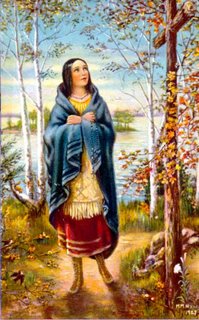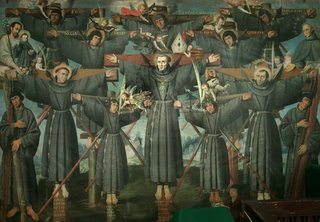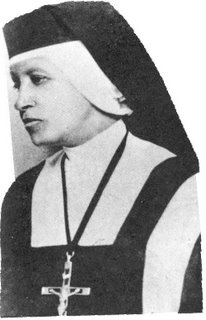
Little Kateri's life started out well enough in that she was the daughter of a Mohawk Chief and a Catholic Algonquin mother. And it would be at her mothers knees that little Kateri would listen to her soothing prayers to a man named Jesus and saw for herself the peace that lay within her mothers heart. And from both her father and mother little kateri learnt to love and respect nature as a provider and also a nurturer.
But Kateri's family life was cut short when an epidemic of small pox raged through her village near Auriesville New York in 1660. Kateri was lucky to have survived this disease and was left scarred and visually impaired through this dreaded illness. Little Kateri found herself orphaned at the early age of only four years old, she was soon adopted by an uncle who was also a Mohawk Chief.
Things worked out well enough for a while for the little Kateri as she blossomed under the care of her Uncle and Aunts and took part in village life as she helped tended the fields and other chores to help provide for their livelihood. But Kateri never lost the memory of her gentle mother and the soothing prayers her mother would whisper at night.
And many times Kateri would wander out into the forest to whisper her own thoughts to this land that she loved so well. Through her vision impairment, Kateri became more sensitive and intuitive to her surroundings and could sense things more clearly as her other sensed were honed to compensate for her loss of clear vision. This also allowed her gentle and sweet nature to shine for all to see as she also came close to a longing for the peace that she remembered in her mothers short life, and reflected on the stories of the Catholic Faith her mother shared with her at night when Kateri would prepare for sleep.
Kateri longed to know of this God who was gentle and mild and in mother nature she could sense the Presence of God all around her. She would hear the whisper of God's voice in the breeze and smell the beauty of His Presence in the wild flowers and earthy ground as she stepped on the fallen leaves. But it was in her inner heart that she could sense a stirring that owed nothing to the wind or scents that were wafting in the breeze, instead she sensed an inner calling of a Father to His child a longing to be closer to the Eternal Presence of the Almighty.
Though Kateri could sense all these things she kept these thoughts hidden in her heart of hearts for many years and continued to live with her adopted family and partake in the chores and share in the village life of those who supported themselves from the land of their birth.
But it was a visit from a Priest that would change Kateri's life, and though her uncle disapproved of these Missionaries he did allow Fr. de Lamberville to set up a mission in his area. When upon meeting the missionary Father de Lamberville, fond memories of her mothers faith came back and Kateri's heart searched for this love of God that had been hidden within for many years.
Upon consulting with her Uncle, Kateri was given permission to learn about the Catholic Faith and its beliefs, her uncle would come to regret this decision when at at age 20 Kateri was baptized into the Catholic Church. And it was here that the name Kateri was given her which means Catherine in English.
But the conversion of Kateri would cause major disruption and outright ridicule from her nearest relatives as they refused to acknowledge Kateri's baptism into the Catholic Faith. This led to outright condemnation and persecution when Kateri refused to work on Sundays, so due to this her Uncle and Aunts refused to give Kateri any food on that day. Things would get worse as Kateri found herself suffering the taunts of little one's and with threats of torture if she did not renounce her new Faith.
This persecution led Kateri to leave the village and her people whom she loved so dearly, but her love for God was greater. So came a mammoth journey as this vision impaired woman walked a staggering 200 miles through unmanageable land and rough terrain so she could reach the safety of the Mission of St. Francis Xavier near Montreal Canada. We must also remember that this courageous young woman wore only the basics in shoe covering could carry no supplies for her journey and all this through all manner of weather.
Because of the courage that Kateri had shown when she fled her village rather than give up her Faith, she was allowed to receive her First Holy Communion on Christmas day in 1677. This was a momentous day for Kateri as she felt the loving spirit of her mother close to her and that she had finally received her beloved Jesus in the Eucharist.
Kateri may have lacked the skills to read and write, still her spiritual life flourished as she embraced a life of prayer and very austere penances. But though Kateri had suffered much, she never lost her peace of heart and remained a serene and loving individual to all who met her. One of Kateri's favourite things to do was to fashion wooden crosses and lay them in the surrounding acres as she prayed the Stations of the Cross.
Prayer became an essential part of Kateri's life and even in the most bitter of winter weather many people would see Kateri kneeling in the snow in freezing conditions praying to God before a Cross she had fashioned out of wood. She also wore a Rosary around her neck in honour of the Blessed Mother whom she loved dearly and embraced as her own mother.
Many people would flock around so they could be in the presence of this wonderful girl, for her love of God shone in her face and in times of bleak austerity Kateri showed what loving God could achieve for the soul, who abandons themselves to Him. She would spend many hours praying before the Blessed Sacrament, her face glowing with an inner light as she very simply loved God and He loved her.
It was while she was at prayer that Kateri promised the Lord to live a life of chastity and devote her whole being to Him as she continued to practice severe mortifications and penances. But even though Kateri was cautioned against too much mortification still she continued this practice.
But due to these penances and the severe winters praying in freezing temperatures, all of this took its toll on Kateri's fragile health. But through the life of Kateri, she showed that God does not ask for great knowledge or lengthy debates on theology, what God asks for is Love and Kateri excelled at loving God and her neighbour.
Kateri Tekakwitha died in 1680.
Blessed Kateri Tekakwitha was beatified in 1980 by Pope John Paul II.
Peace of Christ to ALL
Copyright © 2006 Marie Smith. All rights reserved.

